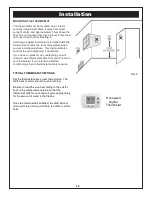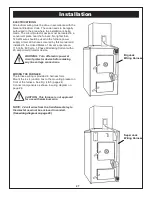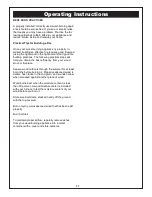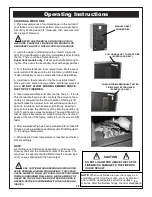
TO FUNCTION PROPERLY AND SAFELY
, it is impera-
tive that the draft regulator when installed in the Tee
stub, is pointing away from surrounding walls or obstruc-
tions. (See Fig. 12) Placement of draft regulator pointing
toward nearby wall(s) or obstruction(s) could result in a
hot spot on the exposed surface and subsequent fire
hazard.
REGARDLESS OF LOCATION AND POSITION
, the
Tee stub opening MUST be plumb (perpendicular) for
the draft regulator to function properly.
AFTER THE TEE SECTION LOCATION HAS BEEN
DETERMINED
, secure the section with both ends to
adjacent sections of standard smoke pipe. Three sheet
metal screws placed at equal distance around each end
of pipe will hold it firmly in place.
INITIAL SETTING OF BAROMETRIC DRAFT
REGULATOR
Before adjusting the draft regulator, be sure there is a
good fire burning.
Set the regulator at a maximum of -.03 to -.04 or as low
a draft as will give good combustion and meet the
requirements for heat. Turn adjustment weight counter-
clockwise to loosen, then slide in slot to proper position
and tighten. Bracket is marked 2, 4, 6, and 8, which
indicates draft settings of .02, .04, etc. (These are drafts
in flue adjacent to control, not over-fire drafts.)
A manometer must be used to accurately adjust flue
draft.
SETTING THE BAROMETRIC DRAFT REGULATOR AND SOME INFORMATION ON CREOSOTE
CREOSOTE BUILD UP
- Creosote, in a vaporized state,
is present in the gases emitted by burning wood and is
highly combustible in its solid and semi-liquid states.
Creosote may build up on the interior surface of the
chimney and subsequently reduce the draft opening. A
DANGEROUS CHIMNEY FIRE MAY RESULT IF ANY
APPRECIABLE CREOSOTE BUILD UP IS PERMIT-
TED.
ADVERSE CONDITIONS CONDUCIVE TO CREO-
SOTE BUILD UP
- Creosote condenses from the flue
gases more rapidly when the temperature in the chim-
ney is cool. The amount of creosote build up is
dependent on:
Ÿ
The amount of moisture in the flue gases
Ÿ
The temperature of the stack
Ÿ
The rate at which the wood is burned
Ÿ
The amount of draft in the stack
Ÿ
How completely the combustible elements in the
flue gases have been burned in the combustion
chamber
Most problems with creosote are due to insufficiently dry
or cured wood, inadequate chimneys with low draft and
cold walls (below 250°F), and/or too low a rate of burn-
ing when little heat is required during spring and fall
months.
CONTROL OF CREOSOTE
- Moisture in the flue
gases may be controlled by:
Ÿ
Using properly seasoned fire wood
Ÿ
Mixing small pieces of air dried wood with every
load
Ÿ
Never using only large wood (usually less dry)
during mild weather when combustion is relatively
slow
The temperature in the stack may be controlled by:
Ÿ
Using as short a length of stove pipe as possible
between the appliance and the chimney
Ÿ
Using an insulated (double wall) smoke pipe to
connect the appliance to the chimney
The amount of draft in the stack may be improved by:
Ÿ
Having as few bends as possible
Ÿ
Insuring adequate chimney height and preventing
air leaks
Ÿ
Eliminating external obstructions in the chimney
outlet
Ÿ
Having only one appliance per flue (Code)
REMOVAL OF CREOSOTE
- Accumulations of
creosote in smoke pipe and chimney flue should be
removed on a regular basis by dismantling and scraping
connector pipes and by scraping and brushing flue until
free of deposits. In many areas there are professional
chimney cleaning services available to perform this
cleaning operation.
FIG. 12
Installation
33
Tee Stub with
Draft Regulator
Summary of Contents for SUPER SJ125
Page 11: ...3 1 2 4 5 6 7 8 9 Furnace Features SJ125 ...
Page 13: ...1 2 3 4 5 6 7 Furnace Features BJ90 13 ...
Page 46: ...SUPER JACK SJ125 Exploded Views Parts Lists 46 ...
Page 48: ...BIG JACK BJ90 Exploded Views Parts Lists 48 ...
Page 53: ...Notes ...
Page 54: ...Notes Notes ...
Page 55: ...Notes ...
















































